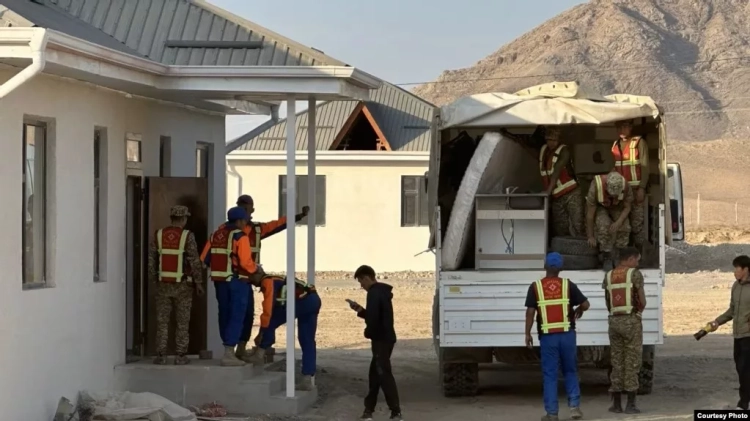
The temporary retreat of Soviet troops at the beginning of the war required urgent measures to...

Before the revolution, there were 107 Russian schools in Kyrgyzstan, where, in addition to Russian...

Since 1998, the reduction in the number of preschool institutions has been halted, and a...

During the war, the capital was the center of scientific thought in the republic, and the science...

From March 24 to 26, 2015, festivals of kindergartens on jailoo were held in the Kara-Kulja, Alay,...

Problems of Orphanage Graduates Discussed Again in Kyrgyzstan A round table titled "Graduate...

The Rear in Kyrgyzstan Industry. A significant part of the European territory of the USSR was at...
In Manas, as part of the operation "Teen-Night," law enforcement officers drew up 32...

DECREE OF THE COUNCIL OF PEOPLE'S COMMISSARS OF THE KYRGYZ SSR "ON TEMPORARY HOUSING...

The Public Charitable Foundation (PCF) "Oasis" together with the Public Association (PA)...

Activities of the Councils of Workers' Deputies in Military Conditions The Councils of...

Children's Camp in Besh-Kunge The main objective of the camp is to create optimal conditions...

In response to the request of the Frunze Mechanical Plant, on February 2, 1942, the Executive...

To ensure the tasks of reconstructing the national economy for military purposes, from the very...

Babich Valentina Vasilievna Candidate of Technical Sciences, laureate of the State Prize of the...

Thanks to the selfless labor of collective farm workers, MTS employees, and state farm workers,...

In the photo: Students and teachers from Gymnasium No. 1 in Chui region and School No. 52 in the...

DECISION OF THE EXECUTIVE COMMITTEE OF THE FRUNZE CITY COUNCIL OF WORKERS' DEPUTIES "ON...

Mobilization of All Internal Resources of the Kyrgyz SSR Speedy construction methods, which...

An interactive museum exhibition on traditional ecological knowledge for children will open at the...

During the war, many vivid heroic-patriotic essays were published in the republic, revealing the...

Placement and Restoration of Relocated Factories and Plants in Kyrgyzstan In the summer of 1942,...

Development of Industry and Culture in the Capital The number of industrial enterprises and...
A new branch of school No. 40 has been launched in the capital, located in a residential complex...

The war required the mobilization of large human and material resources. It was the organization...

Uzakov Orozali Zhaanbaevich (1956), Doctor of Medical Sciences (1991) Kyrgyz. Born in the village...

The communication authorities also improved their work. In a record short time—from July to...

Students of the International University "Atatürk-Alatoo" have published a manual titled...

FROM THE REPORT OF THE COUNCIL OF MINISTERS OF THE KYRGYZ SSR TO THE COUNCIL OF MINISTERS OF THE...

The war exacerbated the situation regarding the supply of oil to the country's industry and...

The results of 1941 indicate the enormous economic potential of the collective farms and state...

The local authorities showed particular concern for the veterans of the Great Patriotic War and...

A magical performance for children featuring long-awaited New Year characters! Art Loft VMeste and...

Today, March 22, an official opening of two rooms took place at the Lenin District Court in...

Prose writer M. Menshikov was born in the village of Kuzino in the Makhnevsky district of the...

The significance of rural architecture in the life of Kyrgyzstan is very great, as more than half...

In the reading room of the Chernyshovsky Library FROM THE REPORT OF THE CHAIRMAN OF THE CULTURE...

We invite everyone to the sixth annual charity festival "Kyrgyzstan - the Land of Skiing and...

Industrial Construction in All Rear Areas of the Soviet Union In the Kyrgyz SSR, as in all rear...

A state insurance company is set to start operating in Kyrgyzstan on January 1, 2016. This was...

Convoy with bread. Kyrgyz SSR 1942 Steps in the Study of Kyrgyzstan's History during the...

On September 12, 1941, the Council of People's Commissars of the Kyrgyz SSR established a new...

According to the information, the construction of 181 residential houses has been completed in the...

The company "Mary Poppins" together with the café "Moskva" invites everyone to...

FROM THE REPORT OF THE CENTRAL COMMITTEE OF THE COMMUNIST PARTY (B) OF KYRGYZSTAN AND THE COUNCIL...

THE BRANCH OF THE RUSSIAN NETWORK OF CHILDREN'S CENTERS "POINT OF GROWTH" invites...